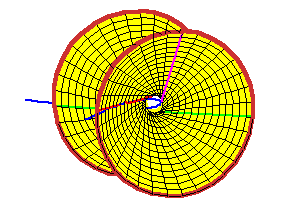

| Discriminant Conjecture |


|
|
The discriminant is easy to compute for the problem of four lines. If the lines are tangent to the rational normal curve at the points g(s), g(t), g(u), and g(v), then the discriminant is |
 |
Shapiro's Conjecture was proven for
m=3 and p=2 by computing a specialization of the
discriminant where one parameter was set to 0 and another
was set to infinity.
The discriminant has degree 20 in four parameters
s1, s2, s3,
and s4, with 711 terms.
Brute force techniques showed that it was a sum of 232 squares,
each a product of square differences of the parameters,
(si - sj )2
or squares of the parameters si2
(when sj=0).
Discriminant Conjecture
The discriminant of any polynomial system formulation of
Shapiro's Conjecture is a sum of
products of squared differences in the parameters
si.
This has been proven in a few cases.